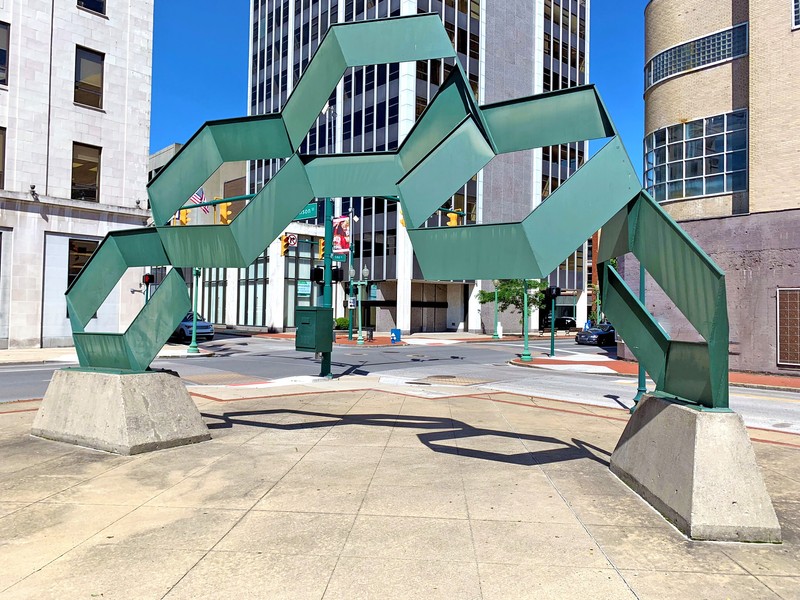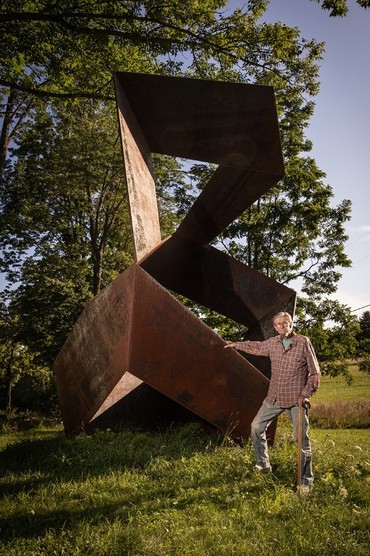Charleston Arch
Introduction
Text-to-speech Audio
Images
Charleston Arch.

Ginnever standing with one of his works.

Backstory and Context
Text-to-speech Audio
Charleston Arch was the result of a $27,500 grant the city of Charleston received in 1980. The Kanawha Arts Alliance, Charleston's City Beautification Commission, and the West Virginia Arts and Humanities Commission were all involved in the project. Three artists were invited to Charleston to compete to have their work commissioned. The artists were shown the site and paid an honorarium and expenses to create scale models of the work they would erect there. The models were then displayed in prominent public places next to ballot boxes, so that Charleston residents could evaluate the works and vote on their favorite design. Accompanying the competition, prominent art historians hosted television programs discussing the artist's proposed works in the context of developments in contemporary art. Charles Ginnever's Charleston Arch received a lion's share of the votes, and was installed in October of 1980. An anecdotal story states that the arch initially had no concrete bases, and instead rested directly on the ground. The story contends that this changed after a city employee bumped their head on the arch while walking through it, so the work was raised. It is unclear if this is a factual retelling, an embellished story designed to explain why the work was raised, or if the piece was always intended to rest on bases.
The sculptor of Charleston Arch, Charles Ginnever, was an American artist who helped push the boundaries of public abstract art. He believed in the power of public art to enhance and enliven communities. His large-scale steel sculptures can be found throughout the United States and in collections all over the world. However, Charleston Arch is the only public Ginnever work in West Virginia. Ginnever passed away in 2019.
Sources
Charleston Arch, (sculpture), Smithsonian. Accessed December 15th 2020. https://www.si.edu/object/siris_ari_310484.
Genzlinger, Neil. Charles Ginnever, Sculptor on a Grand Scale, Dies at 87, The New York Times. June 25th 2019. Accessed December 15th 2020. https://www.nytimes.com/2019/06/25/arts/charles-ginnever-dead.html.
Main Post Office - Charleston, WV, The Living New Deal. Accessed December 15th 2020. https://livingnewdeal.org/projects/main-post-office-charleston-wv/.
Charles Ginnever, Artists Forum. Accessed December 15th 2020. https://www.artistsforum.com/Ginnever/biography.html.
Department of the Interior and Related Agencies Appropriations for 1983: Hearings Before a Subcommittee of the Committee on Appropriations, House of Representatives, Ninety-seventh Congress, Second Session, Part 3. Washington, D.C.. U.S. Government Printing Office, 1982.
Fleming, Ronald Lee and Renata Von Tscharner. The City as Public Art. Design for Arts in Education, vol. 85, no. 112 - 16. Published January 1st 1983.
Collins, Rodney S. Downtown Charleston Historic District, National Register of Historic Places. February 7th 2006. Accessed December 15th 2020. https://s3.amazonaws.com/NARAprodstorage/lz/electronic-records/rg-079/NPS_WV/06000166.pdf.
Office of Public Art - Charleston, WV. Accessed December 15, 2020. https://www.facebook.com/publicartcharlestonwv/posts/charles-chuck-ginnever-the-sculptor-that-created-charleston-arch-has-died-at-age/483694415736942/.
Office of Public Art - Charleston, WV. Accessed December 15, 2020. https://www.facebook.com/publicartcharlestonwv/posts/charles-chuck-ginnever-the-sculptor-that-created-charleston-arch-has-died-at-age/483694415736942/.
